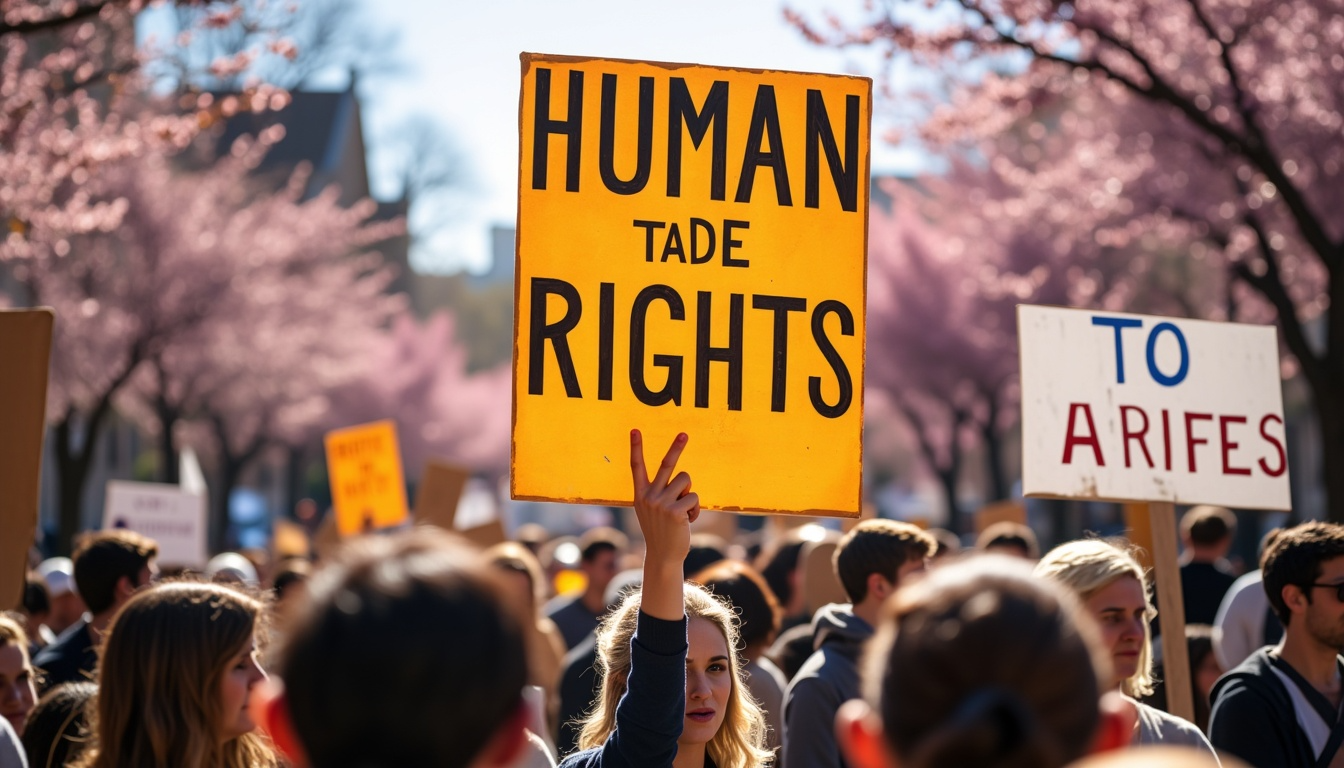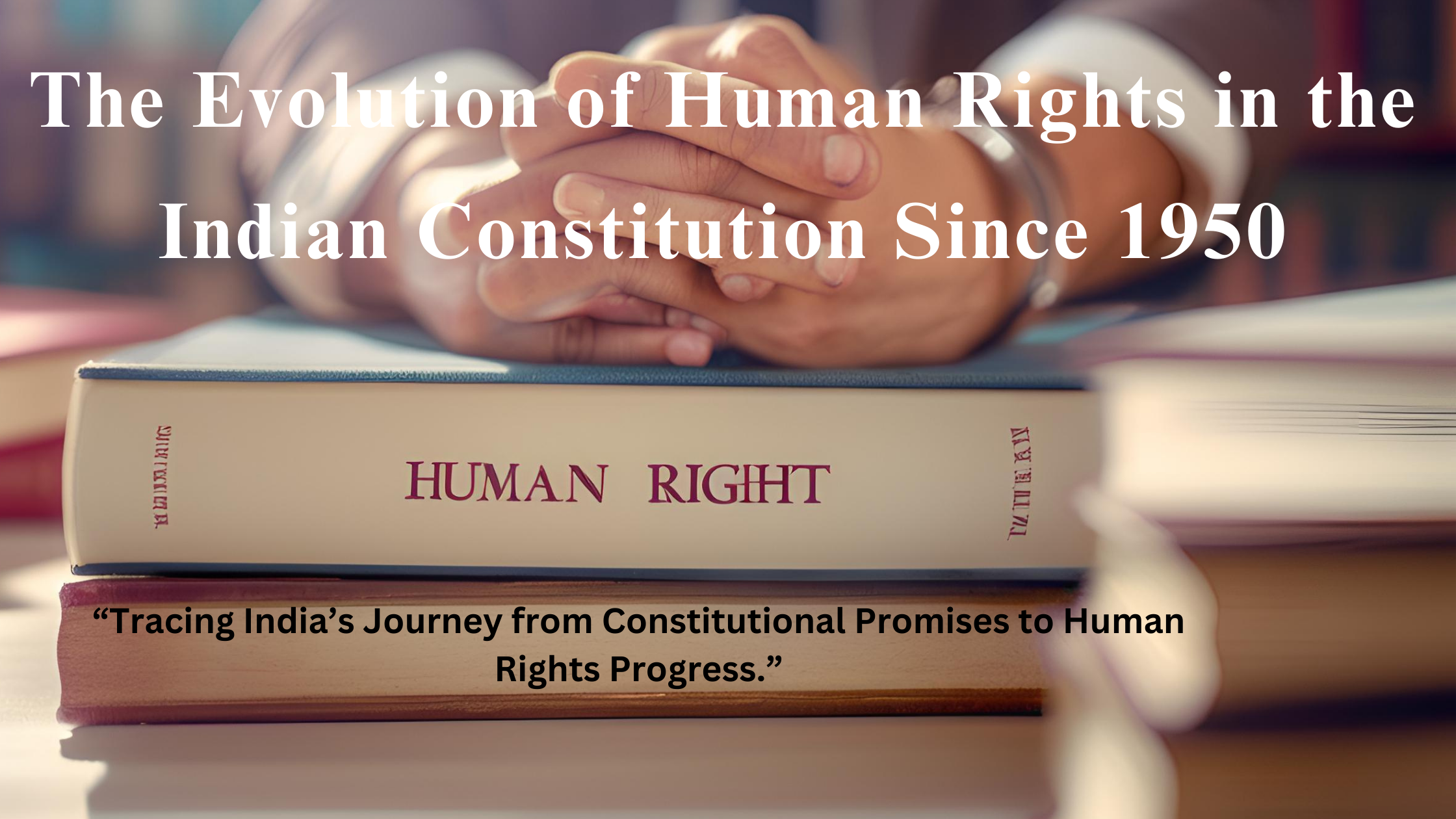This powerful blog uncovers the dynamic evolution of human rights in India since 1950, spotlighting landmark judgments, transformative laws, and bold constitutional provisions that empower justice, equality, and freedom.
Introduction
In 1950, India’s newly adopted Constitution became a beacon of hope for a nation emerging from colonial rule and centuries of social inequality. It promised not just political freedom but dignity, justice, and equality for every citizen. Over the past seven decades, this promise has evolved through landmark judgments, social struggles, and amendments, reflecting India’s journey from a rigid legal framework to a dynamic, Human Rights-based democracy. This blog traces the transformative arc of human rights in India’s Constitution, revealing how words on parchment became tools of empowerment for millions.

The Indian Constitution, drafted under Dr. B.R. Ambedkar’s leadership, was revolutionary for its time. It rejected the caste hierarchy and colonial oppression, embedding rights into three core parts:
- Fundamental Rights (Part III): Enforceable legal guarantees like:
- Equality (Articles 14–18): Abolition of untouchability, equal access to public spaces.
- Freedom (Articles 19–22): Rights to speech, religion, and protection against unlawful detention.
- Against Exploitation (Articles 23–24): Ban on human trafficking and child labor.
- Directive Principles of State Policy (Part IV): Aspirational goals like free education, living wages, and village self-governance.
- Preamble: Declared India a “sovereign, socialist, secular, democratic republic” committed to justice, liberty, and fraternity.
Why It Mattered:
For the first time, marginalized groups like Dalits, women, and religious minorities had legal tools to challenge oppression.st, secular, democratic republic” committed to justice, liberty, and fraternity.
2. 1960s–1970s: Testing the Constitution’s Resilience
The initial decades saw clashes between parliamentary power and judicial oversight:
- First Amendment (1951): Restricted free speech to prevent hate speech but raised concerns about censorship.
- Golaknath Case (1967): The Supreme Court ruled Parliament couldn’t amend Fundamental Rights. This was overturned in the Kesavananda Bharati Case (1973), which introduced the “Basic Structure Doctrine”—a judicial safety net to prevent the Constitution’s core values (like democracy and human rights) from being erased.
The Emergency (1975–77):
A turning point. Indira Gandhi’s government suspended rights, jailed dissenters, and imposed press censorship. The aftermath led to:
- Wider Interpretation of Article 21: The Maneka Gandhi Case (1978) expanded “right to life” beyond mere existence to include dignity, privacy, and fair procedure.
3. 1980s–1990s: Judicial Activism and Social Justice
Courts began bridging the gap between law and ground realities:
- Public Interest Litigation (PIL): Justice P.N. Bhagwati opened courts to marginalized groups. For example:
- Landmark Judgments for Marginalized Groups:
- Mohini Jain v. Karnataka (1992): Recognized education as part of the “right to life.”
- Indra Sawhney v. Union of India (1992): Upheld 27% OBC reservations, promoting social equity.
Legislative Reforms:
- The Scheduled Castes and Scheduled Tribes (Prevention of Atrocities) Act, 1989 addressed caste-based violence.
- Panchayati Raj Act (1993): Reserved seats for women in local governance.
4. 2000s–2010s: Expanding Horizons
Globalization and digitalization reshaped rights:
- Right to Information Act (2005): Empowered citizens to demand transparency.
- Right to Education Act (2009): Made schooling free and compulsory for children aged 6–14.
- Privacy as a Fundamental Right (2017): In Justice K.S. Puttaswamy v. Union of India, the Supreme Court declared privacy intrinsic to dignity.
Socially Progressive Judgments:
- Navtej Singh Johar v. Union of India (2018): Decriminalized homosexuality.
- Joseph Shine v. Union of India (2018): Struck down adultery as a criminal offense.
- Shayara Bano v. Union of India (2017): Abolished instant triple talaq, protecting Muslim women’s rights.
5. Grassroots Movements: The People’s Constitution
Human rights expanded because ordinary citizens demanded change:
- Women’s Rights: The 2012 Nirbhaya protests led to stricter rape laws and fast-track courts.
- LGBTQ+ Rights: Activists like Akkai Padmashali and organizations like Naz Foundation fought tirelessly against Section 377.
- Environmental Justice: The Chipko Movement (1970s) and Narmada Bachao Andolan (1980s) inspired courts to recognize the “right to a clean environment.”
Example: The Forest Rights Act (2006), born from tribal movements, granted land rights to forest-dwelling communities.
6. Global Influences and Modern Challenges
India’s rights framework has been shaped by global commitments:
- UN Human Rights Treaties: The Convention on Elimination of Racial Discrimination (CERD) and Convention on the Rights of the Child (CRC) influenced laws like the Juvenile Justice Act (2015).
- Digital Age Dilemmas: New threats like surveillance (Pegasus spyware scandal) and data privacy gaps test the Digital Personal Data Protection Act (2023).
Persistent Issues:
- Caste Violence: Despite laws, atrocities against Dalits rose by 9% in 2021 (NCRB data).
- Gender Inequality: Marital rape remains legal; women hold only 14% of parliamentary seats.
- Conflict Zones: AFSPA in Kashmir and Northeast grants military immunity, leading to alleged human rights abuses.
7. The Road Ahead: Reimagining Rights for the 21st Century
To make rights meaningful for all, India must:
- Strengthen Implementation: Train police, streamline courts, and raise awareness.
- Update Laws: Criminalize marital rape, enact anti-discrimination laws for LGBTQ+ communities.
- Leverage Technology: Use AI for faster justice delivery and apps to report rights violations.
- Promote Inclusive Dialogue: Address concerns around laws like the Citizenship Amendment Act (CAA) and Uniform Civil Code (UCC).
Hope in Action:
- The Bilkis Bano Case (2024): Supreme Court’s reversal of remission for convicts shows judicial courage.
- Climate Justice: Courts are linking environmental protection to Article 21, as seen in Delhi’s pollution control measures.
Conclusion: The Constitution as a Living Document
India’s Constitution is not a relic but a resilient, evolving force. From abolishing untouchability to recognizing digital privacy, it has grown through the courage of judges, activists, and ordinary citizens. Yet, the true test lies in ensuring a landless laborer, a transgender student, or a dissenting journalist can access these rights equally. As Dr. Ambedkar warned, “Constitutional morality is not a natural sentiment. It must be cultivated.” The journey continues.

